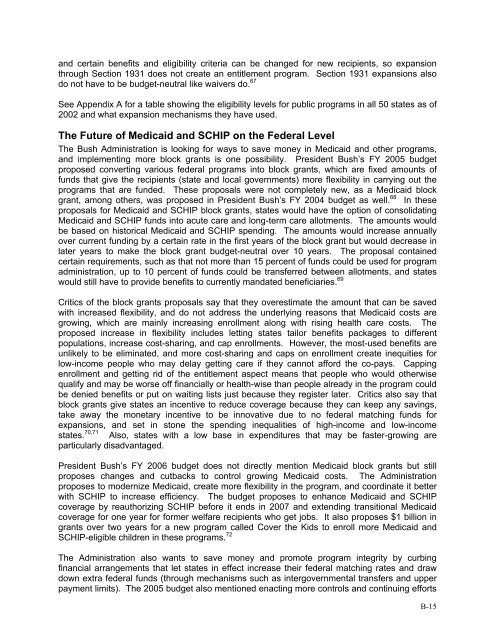COD E R E D
Download - Code Red: The Critical Condition of Health in Texas
Download - Code Red: The Critical Condition of Health in Texas
- No tags were found...
You also want an ePaper? Increase the reach of your titles
YUMPU automatically turns print PDFs into web optimized ePapers that Google loves.
and certain benefits and eligibility criteria can be changed for new recipients, so expansionthrough Section 1931 does not create an entitlement program. Section 1931 expansions alsodo not have to be budget-neutral like waivers do. 67See Appendix A for a table showing the eligibility levels for public programs in all 50 states as of2002 and what expansion mechanisms they have used.The Future of Medicaid and SCHIP on the Federal LevelThe Bush Administration is looking for ways to save money in Medicaid and other programs,and implementing more block grants is one possibility. President Bush’s FY 2005 budgetproposed converting various federal programs into block grants, which are fixed amounts offunds that give the recipients (state and local governments) more flexibility in carrying out theprograms that are funded. These proposals were not completely new, as a Medicaid blockgrant, among others, was proposed in President Bush’s FY 2004 budget as well. 68 In theseproposals for Medicaid and SCHIP block grants, states would have the option of consolidatingMedicaid and SCHIP funds into acute care and long-term care allotments. The amounts wouldbe based on historical Medicaid and SCHIP spending. The amounts would increase annuallyover current funding by a certain rate in the first years of the block grant but would decrease inlater years to make the block grant budget-neutral over 10 years. The proposal containedcertain requirements, such as that not more than 15 percent of funds could be used for programadministration, up to 10 percent of funds could be transferred between allotments, and stateswould still have to provide benefits to currently mandated beneficiaries. 69Critics of the block grants proposals say that they overestimate the amount that can be savedwith increased flexibility, and do not address the underlying reasons that Medicaid costs aregrowing, which are mainly increasing enrollment along with rising health care costs. Theproposed increase in flexibility includes letting states tailor benefits packages to differentpopulations, increase cost-sharing, and cap enrollments. However, the most-used benefits areunlikely to be eliminated, and more cost-sharing and caps on enrollment create inequities forlow-income people who may delay getting care if they cannot afford the co-pays. Cappingenrollment and getting rid of the entitlement aspect means that people who would otherwisequalify and may be worse off financially or health-wise than people already in the program couldbe denied benefits or put on waiting lists just because they register later. Critics also say thatblock grants give states an incentive to reduce coverage because they can keep any savings,take away the monetary incentive to be innovative due to no federal matching funds forexpansions, and set in stone the spending inequalities of high-income and low-incomestates. 70,71 Also, states with a low base in expenditures that may be faster-growing areparticularly disadvantaged.President Bush’s FY 2006 budget does not directly mention Medicaid block grants but stillproposes changes and cutbacks to control growing Medicaid costs. The Administrationproposes to modernize Medicaid, create more flexibility in the program, and coordinate it betterwith SCHIP to increase efficiency. The budget proposes to enhance Medicaid and SCHIPcoverage by reauthorizing SCHIP before it ends in 2007 and extending transitional Medicaidcoverage for one year for former welfare recipients who get jobs. It also proposes $1 billion ingrants over two years for a new program called Cover the Kids to enroll more Medicaid andSCHIP-eligible children in these programs. 72The Administration also wants to save money and promote program integrity by curbingfinancial arrangements that let states in effect increase their federal matching rates and drawdown extra federal funds (through mechanisms such as intergovernmental transfers and upperpayment limits). The 2005 budget also mentioned enacting more controls and continuing effortsB-15







